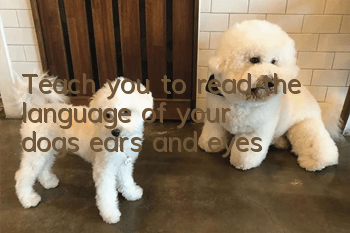Teach you to read the language of your dog’s ears and eyes

Chatting with a dog is not difficult at all. The key is that you have to be familiar with the dog's language and understand it with your heart. This will help you better understand the dog. Do you understand the language of the dog's ears?
Dogs have extremely flexible ears that can easily and keenly detect various sound signals coming from different directions, and are also used to transmit communication signals. There are various ear shapes, among which upright ears are more conducive to communication than drop ears or pruned ears. Taking erect ears as an example, common ear signals include ears standing upright and slightly forward, which is a signal for dogs to pay attention; ears facing completely forward, combined with exposed teeth and wrinkled nose, show dominance and self-confidence. Dogs will actively attack; ears behind Laying flat on the head and exposing teeth is a signal of uneasiness, and is a signal of fear and aggression displayed by non-dominant dogs when they feel threatened;
The ears are flat with no teeth visible, the forehead is flat, and the body is tilted downward, which is a signal of active begging and submission; the ears are later turned down and slightly flared, indicating tension and uneasiness about the unknown situation, depending on what happens next. May quickly turn into aggression or fear; ears flicking, usually slightly forward, then slightly backward or downward, is a sign of submission and begging conveyed by a hesitant and possibly fearful dog; when the ears are placed back but very When soft, it shows no interest or coquettishness.
The dog's eyes also convey important communication signals: looking directly is an active dominance and aggressive signal, generally used by confident dogs when facing other dogs in the group; looking away to avoid frontal contact shows Submission, fear, or withdrawal; blinking or flickering of the eyes, along with a calming gesture in response to a threatening direct gaze, can reduce the level of hostility toward the other person but yield little in terms of their group status.
The general rule of eye signals is: the larger the pupil, the greater the dog's mood and alertness; the rounder and larger the eye shape, the stronger the dominance and threat in the signal; the smaller the eyes, half-closed or closed, the more submissive it is. and begging for peace.
Changes in a dog's mood can be seen in a dog's eyes. When a dog is angry, its pupils open and its eyes hang up, turning into a scary look; when it is sad and lonely, its eyes are moist; when it is happy, its eyes are bright; when it is confident or hopes to be trusted, it will never look away; When you feel pressured by someone or make a mistake, you will move your eyes slightly; when you don't trust someone, your eyes will flicker.
- How to make your dog like to eat dog food Four ways to make your dog fall in love with dog food
- How to protect your dog’s food? Teach you tips on training your dog
- What should I do if my dog has lupus? Immune system diseases should not be underestimated
- If your dog's hair is cut and the skin is cut, the flesh is exposed. If the dog's hair is accidentally cut and the skin is cut, it must be disinfected immediately.
- Do dogs need deworming in summer? What should you pay attention to when raising dogs in summer?
- What to do if your dog has indigestion? Dog indigestion is no small matter!
- What should you pay attention to when vaccinating your dog? What should you pay attention to when vaccinating your dog?
- Symptoms of Rheumatism in Dogs What conditions can cause rheumatism in dogs?
- What to do if dogs fight at home? The owner is the best mediator
- What are the reasons why dogs are obese? Do you know these four reasons?



